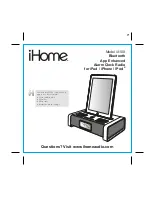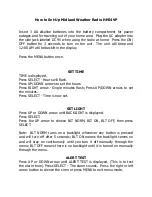
PRO-2041 Scanner
(200-0463) General Guide to Scanning Faxback Doc. # 38900
Reception of the frequencies covered by your scanner is mainly "line -
of-sight." That means you usually cannot hear stations that are beyond
the horizon.
GUIDE TO FREQUENCIES
US Weather Frequencies
162.400 162.425 162.450 162.475 162.500 162.525 162.550
Other Weather Frequencies
161.650 161.775 162.440 163.275
Ham Radio Frequencies
Ham radio operators often transmit emergency information when other means
of communication break down. The following chart shows the frequencies
the scanner receives that Ham radio operators normally use:
Wavelength (meters) Frequencies (MHz)
10-Meter 29 .000-29.700
6-Meter 50.000 -54.000
2-Meter 144.000 -148.000
70-cm 420.000 -450.000
33-cm 902.000 -928.000
Birdie Frequencies
Every scanner has birdie frequencies. Birdies are signals created inside
the scanner's receiver. These operating frequencies might interfere with
broadcasts on the same frequencies. If you program one of these
frequencies, you might be able to turn SQUE LCH clockwise to cut out the
birdie.
The birdie frequencies on this unit to watch for are:
32.100 36.000 -36.300 40.000 -40.300
41.890 44.100 -44.300 48.100 -48.300
52.100-52.300 108.100 -108.800 112.100 -112.700
120.300-120.500 121.500 128.300 -128.900
136.200-136.800 144.300 -144.800 150.150
152.300-152.800 155.500 156.300 -156.500
160.300-160.900 166.200 171.550
400.400 429.050 434.400
450.450 479.100 504.125
810.150 820.650 865.350
915.400 944. 050
To find the birdies in your scanner, begin by disconnecting the antenna
and moving it away from the scanner. Make sure that no other nearby radio
or TV sets are turned on near the scanner. Use the search function and
scan every frequency range from its lowest frequency to the highest.
Occasionally, the searching will stop as if it had found a signal, often






































